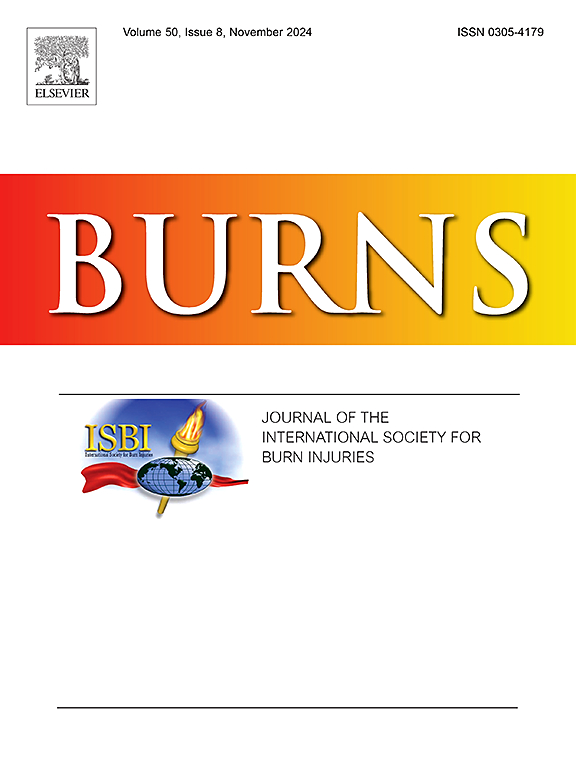核苷结合结构域样受体蛋白3炎性小体参与烧伤后血管内皮屏障功能障碍和休克
IF 2.9
3区 医学
Q2 CRITICAL CARE MEDICINE
引用次数: 0
摘要
目的探讨烧伤引起的全身炎症对血管内皮功能障碍和低血压的影响。本研究旨在探讨核苷结合结构域样受体蛋白3 (NLRP3)炎症小体在烧伤后血管内皮屏障功能障碍中的作用。方法建立sa 30 %体表面积烧伤小鼠模型,烧伤前后分别给予NLRP3特异性抑制剂MCC950(10 mg/kg)。将烧伤大鼠伤后1 d的血清(burn Serum, BS)分别用于人急性单核白血病细胞(THP-1)和人脐静脉内皮细胞(HUVECs),分别添加或不添加10 μ mc950。测定血压、72小时存活率、血清炎症因子(IL-1β、IL-18)、l -乳酸(L-LA)水平和肠系膜动脉Evans蓝染色。在体内和体外检测内皮连接蛋白(VE-cadherin, ZO-1, occludin), MMP-9, NLRP3炎性小体成分(NLRP3, ASC, cleaved caspase-1)和焦亡执行蛋白(gasdermin D蛋白n端片段,GSDMD-N)的蛋白表达。观察huvec的细胞活力和形态变化,以及THP-1细胞上清液中炎症因子的浓度。结果烧伤大鼠肠系膜动脉Evans蓝外渗明显增强,血清炎症因子和L-LA水平升高,血压降低,体内72小时存活率下降。在体内和体外,烧伤或BS暴露导致内皮连接蛋白表达降低,MMP-9、NLRP3炎性小体成分和GSDMD-N表达增加。此外,BS暴露导致huvec细胞活力降低和明显的焦亡形态,THP-1细胞的上清和裂解物中炎症因子升高。MCC950治疗有效地逆转了除NLRP3自身蛋白表达外的所有观察到的变化。结论NLRP3炎性小体的激活与炎症反应增强和内皮细胞焦亡有关,可能导致内皮屏障功能障碍和休克进展。本文章由计算机程序翻译,如有差异,请以英文原文为准。
Nucleotide-binding domain-like receptor protein 3 inflammasome contributes to vascular endothelial barrier dysfunction and shock after burn injury
Objective
Burn injury-induced systemic inflammation significantly contributes to vascular endothelial dysfunction and hypotension. This study aimed to investigate the role of the nucleotide-binding domain-like receptor protein 3 (NLRP3) inflammasome in vascular endothelial barrier dysfunction following burn injury.
Methods
A 30 % total body surface area burn mouse model was established, and MCC950, a specific NLRP3 inhibitor, was administered (10 mg/kg) before and after burn injury. Serum collected from burned rats (burn serum, BS) at one day post-injury was applied to human acute mononuclear leukemia cells (THP-1) and human umbilical vein endothelial cells (HUVECs), with or without 10 μM MCC950. Blood pressure, 72-hour survival rates, serum levels of inflammatory cytokines (IL-1β and IL-18) and L-lactic acid (L-LA), and Evans blue staining of mesenteric arteries were measured. Protein expression of endothelial junction protein (VE-cadherin, ZO-1, occludin), MMP-9, NLRP3 inflammasome components (NLRP3, ASC, cleaved caspase-1), and pyroptosis executioner protein (N-terminal fragment of the gasdermin D protein, GSDMD-N) were examined both in vivo and in vitro. Cell viability and morphological changes of HUVECs, and inflammatory cytokines concentrations in THP-1 cell supernatants were also assessed.
Results
Burn injury significantly enhanced Evans blue extravasation in mesenteric arteries, and increased serum inflammatory cytokine and L-LA levels, accompanied by reduced blood pressure and decreased 72-hour survival rates in vivo. Burn injury or BS exposure led to decreased endothelial junction protein expression and increased expression of MMP-9, NLRP3 inflammasome components, and GSDMD-N both in vivo and in vitro. Furthermore, BS exposure resulted in reduced cell viability and evident pyroptotic morphology in HUVECs, along with elevated inflammatory cytokines in both the supernatants and lysates of THP-1 cells. Treatment with MCC950 effectively reversed all observed changes except for the protein expression of NLRP3 itself.
Conclusion
In burn injury, activation of the NLRP3 inflammasome is associated with enhanced inflammatory responses and endothelial cell pyroptosis, which may contribute to endothelial barrier dysfunction and the progression of shock.
求助全文
通过发布文献求助,成功后即可免费获取论文全文。
去求助
来源期刊

Burns
医学-皮肤病学
CiteScore
4.50
自引率
18.50%
发文量
304
审稿时长
72 days
期刊介绍:
Burns aims to foster the exchange of information among all engaged in preventing and treating the effects of burns. The journal focuses on clinical, scientific and social aspects of these injuries and covers the prevention of the injury, the epidemiology of such injuries and all aspects of treatment including development of new techniques and technologies and verification of existing ones. Regular features include clinical and scientific papers, state of the art reviews and descriptions of burn-care in practice.
Topics covered by Burns include: the effects of smoke on man and animals, their tissues and cells; the responses to and treatment of patients and animals with chemical injuries to the skin; the biological and clinical effects of cold injuries; surgical techniques which are, or may be relevant to the treatment of burned patients during the acute or reconstructive phase following injury; well controlled laboratory studies of the effectiveness of anti-microbial agents on infection and new materials on scarring and healing; inflammatory responses to injury, effectiveness of related agents and other compounds used to modify the physiological and cellular responses to the injury; experimental studies of burns and the outcome of burn wound healing; regenerative medicine concerning the skin.
 求助内容:
求助内容: 应助结果提醒方式:
应助结果提醒方式:


